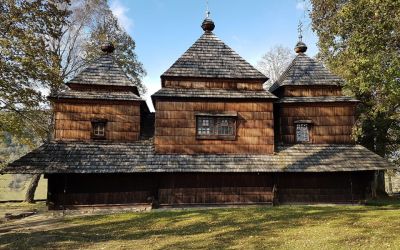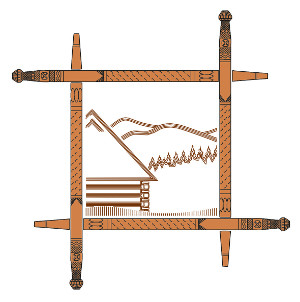
Mountain people are an extremely religious and superstitious community. In their customs many beliefs dating back to the pre-Christian times, which merged with Christianity, have survived. Shepherds who stayed away from the villages, on the mountain pastures for many months, felt exceptionally dependent on the forces of nature, demons, deities, and gods. Christian saints replaced the old, local, gods specializing in specific fields or good spirits. Some were effective in fighting various diseases, others protected dwellings, bridges and crossroads, other ones helped in business or in matchmaking, etc.
The most important patron of Carpathian highlanders in our region, on the Slovak, Ukrainian and Romanian sides is St. Nicholas the Miracle-worker. Apart from many "specializations", which he has there is a special one, he is the patron of Carpathian shepherds. The largest number of Orthodox churches in the mountains is under the call of this saint, and in most of the iconostasis there is his icon in the particular the place of one of the four icons. The Highlanders of the Bieszczady Mountains and the Low Beskids are Boykos and Lemkos, and therefore faithful to the Orthodox or Greek Catholic Church. The same is true for Slovakia, Ukraine and Romania. On the day of the so-called "Warm Nicholas" on May 9th, according to the old system (May 22nd according to the new system), the redyk was going out to the mountain pastures, and the shepherd was lighting the holy fire of cotton wool in a hut. St. Nicholas is considered to be "older among all saints" and "fast assistant”. It is believed that the Christian St. Nicholas replaced the former pagan god called Veles, who took care of cattle and animals.
In the folk space of the Eastern Carpathian Mountains there are 2 calendars, which supplement and complement each other: the Orthodox one and natural one. The first one begins on September 8th - according to Julian calendar, i.e. 21 September according to the Gregorian calendar - the holiday of the Birth of the Mother of God. It ends on August 15 (Julian calendar), i.e. on August 28 (Gregorian calendar). The most important twelve holidays of the year, in addition to the above, include: the Feast of the Holy Cross - September 14 (27), Introduction of the Mother of God to the Temple on November 21 (December 4), Christmas 25 December (7 January), the Epiphany (Baptism in the Jordan) -6 (19) January, Meeting of the Lord (Presentation of Christ in the Temple) - February 2 (15), Annunciation of the Mother of God - March 25th (April 7th), Entry to Jerusalem (Palm Sunday) - one week before Easter,
Resurrection of the Lord – 1st Sunday after the first full moon Sunday, The Ascension Day - 40 days after the Resurrection, Pentecost - 8th Sunday after Easter and Transfiguration of the Lord – 6 (19) August.
Traditional calendar customs and rituals of Lemkos and Boykos were formed into the early stage of the development of society, when the man was closely associated with the surrounding nature. He lived in dependence with natural phenomena, which regulated his work cycle. Cyclicality of seasons (spring, summer, autumn, winter) conditioned the formation of the calendar of customs in accordance with changes in nature. In pre-Christian times the new year began on the equinox in spring, when nature awakens to life, or on 24 December, for the winter solstice - the day of the birth of the god of the Sun. The most joyful was the spring cycle of customs and rituals, when there is "the resurrection" of the plant world, nature, spring works, redyk. On the other hand, the autumn cycle of customs and rituals solemnized the collection of agricultural produce, return with sheep and cattle from the mountain pastures. the year was finished with the winter cycle of rituals, adjusted to the completion of the works. In winter the tools were repaired, a calendar of activities was planned for the season, the shepherd agreed with the gazdas for the quantity of sheep which, in spring he would take for grazing, gather the juhas with whom he agreed to work, made agreements with the owners of the mountain pastures for leasing the areas for sheep grazing.
The beginning of the spring cycle should be regarded as the so-called " mjasnyci " - one of the most joyful periods in the calendar year of people, especially rural residents. At that time, just before the Lent they organized weddings, organized various games. Particularly diverse in character was
the entertainment for young people on the southern slope of the Western Carpathian Mountains. Lemko youth used different masks or rubbed their faces with soot, some paint, sprinkled with flour. Young people and the girls walked from one cottage to another to the delight of the household members. Especially cheerful was the last week of “miastyć”, the so-called "puszczania" (southern Lemkivshchyna), "zapusty” (northern Lemkivshchyna). Girls and boys, men and women would come together to play in the spacious playgrounds (in barns) and organized dances and parties. At midnight on the last day of the "miasnyć" all the games were finished, because the seven-week Great (Easter) fast began. Fasting obliged not only to stop playing, but also to limit consumption of food, especially meat and milk dishes, fats (except oils). Milk was used to make cheese and put it into barrels, which were used after fasting. During the fast adults and children went to confession to "cleanse themselves", "wash themselves" from sins and evil. In the first week of Lent (called Fedorowycia), in many regions of the Lemko region, even cooked dishes were not eaten. They ate dried fruit, baked potatoes and drank cabbage acid (the so-called ‘war’). Women did not spin this week and did not pick the wool. Men made weather forecasts: Monday - weather for sowing, Tuesday - for planting potatoes, Wednesday - hay, Thursday - for harvest, Friday - for digging up potatoes, Saturday - for sowing winter crops. The last Sunday of Lent was called "the Palm Sunday". On that day "Bahniatka" /catkins/ were blessed in the church. They were later held behind the paintings and thrown into the fire during a storm in order to chase the misfortune away. In some villages of the Lemko region, many beliefs connected with various unclean forces referred to the last week of Lent. Generally, in the whole Lemko region and Boyko region, this week was called "Terrible". It was the time when Christ suffered and died on the cross. On Friday, when, according to Christ's evangelical tale, they put up a tomb, the Epitaphios was put up in the church, bells stopped ringing. During the procession around the church, the boys rattled using hand-made wooden "rattles". Near the church in many villages of the northern Lemko region, a fire was set on - a symbol of the guard next to the Lord's grave, which was on until Sunday morning. In Żernica Wyżna it was believed that the fog on Good Friday meant the storm that would come from the side from which the fog came. It was common, in the Slavic region as a whole, to believe that vampires, which had slept underground since the first frosts, woke up at the first spring thunderstorms.
The biggest church holiday was Easter, the time of Christ's Resurrection. It was preceded by serious preparations, tidying the hut and farmyard, baking traditional, ritual cakes. Even in pre-Christian times the Slavs baked great bread decorated with ornaments, painted eggs, cooked other products for the sacrifice of the goddess of spring – Łada. This custom has survived to this day and manifests itself in baking Passover (a big bread), painting eggs (kraszanki, Easter eggs). The products were placed in a ritual basket and carried to the Orthodox churches. The Passover was carried by the landlady or a woman (wife) of the eldest son, the basket was carried by the housekeeper or the oldest son.
On the first day of Easter people did not visit each other. Before they sat at the Easter table, in many regions of the Lemko region, the farmer used to go around the cottage three times with the Passover to protect himself from fires. This custom has survived till today. In other villages, this activity was supposed to support happy farm management all year round and good cattle reproduction. In many villages the landlady walked around the stable with a Passover, visiting the barn so that the farm could be run well. It was common practice to start eating Easter products with an egg, which was cut in as many parts as there were family members. Everyone should have eaten his or her own piece, so that there would always be love and harmony.
On Easter Sunday, after having eaten the blessed food, the youth would go to the outskirts of the village or next to the Orthodox churches, organizing processions with "haiwka". The children spent the whole day ringing the Orthodox church bells. On the second day of Easter, on the Wet Monday, farm workers walked around the village and watched which girl comes out of the cottage to pour water on her. Among the customs of this period an important place (especially for shepherds) was taken by St. George's Day (Jura, Yuriya, Heorhiya), which was celebrated on 23 April (according to the old style, i.e. 6 according to the new one). On that day, for the first time after a long winter, he took the cattle to pasture. It was preceded by a series of rituals and magical actions, which were to protect the cattle from evil forces - the witches. Crosses were painted on the stable door with black slurry, in many villages of the southern and northern Lemkivshchyna with a blessed chalk to protect against evil forces.
The beginning of the redyk, called "Połoniński Chid" in the Eastern Carpathian Mountains was a great event in the village. Baca (the shepherd) walked along with the juhas in the middle of the village, while the hosts joined the sheep or cattle herds, in accordance with pre-established rules. It was also an opportunity to celebrate together. All the way salutes were fired, songs were sung, trumpet was played and hoots could be heard. After mixing sheep from individual gazdas, the whole flock was taken to the mountain pastures.
In the pastoral regions of Lemkivshchyna and Boyko region a very important holiday was the day of
St. Ilia (Elijah) (August 2). Traditionally, "in the shepherd’s hut" bachelors and spinsters met. They made bonfires, sang songs, told various old stories to each other. The most important holiday of farmers was harvest festival (obżynki). Going to the field with sickles, they stood in the direction of sunrise and after saying goodbye they started to mow the grain. A cross was made from the last straws.
An important holiday for shepherds was 1 October according to the Julian calendar (14 X in the Gregorian calendar). At that time it was usually the end of the redyk. Shepherds descended with herds in a solemn parade, it was called "osinnij połonynśkyj chid". Being greeted loudly and joyfully, they handed out their own cheese-made figures to the country ladies and children. In some regions, these were the animal figures of the 'syrowe konyky’ /cheese horses/. Later on, the shepherds met with the gazdas and settled the bills. The sheep then grazed for some time in the countryside meadows and then they were taken to a so-called wintering ground. The wintering grounds were called glades, where there were sheds, where the hay harvested in the summer was stored under the roof on the ceiling.














